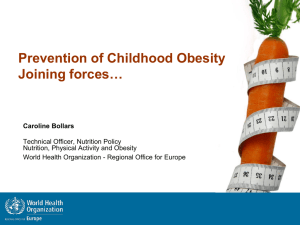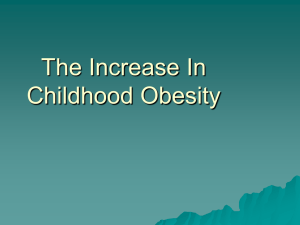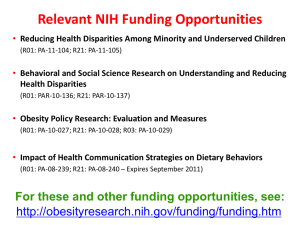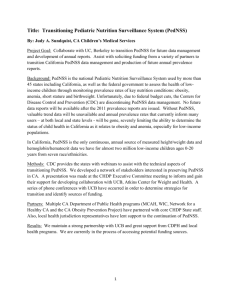Linking Personal Responsibility, Economics, and Policy Change to
advertisement
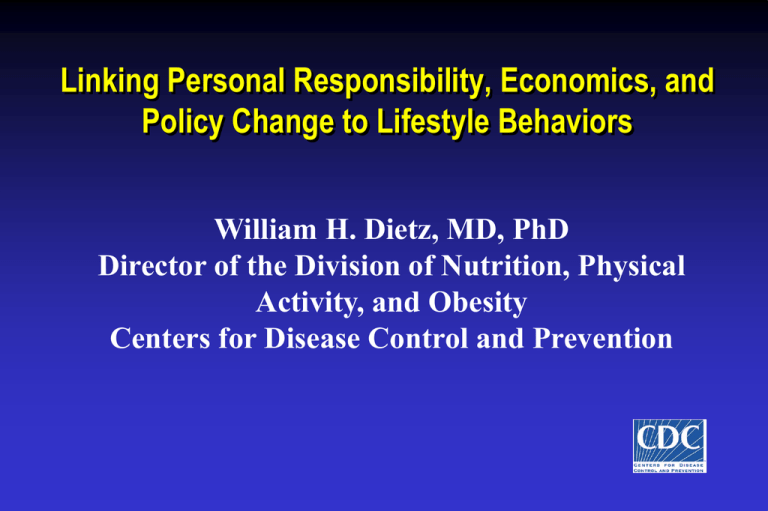
Linking Personal Responsibility, Economics, and Policy Change to Lifestyle Behaviors William H. Dietz, MD, PhD Director of the Division of Nutrition, Physical Activity, and Obesity Centers for Disease Control and Prevention Obesity Trends Among U.S. Adults BRFSS, 1990, 1999, 2009 1999 1990 2009 No Data <10% 10%–14% 15%–19% 20%–24% 25%–29% ≥30% Changes in Obesity Prevalence by Race/ethnicity, Boys 2-19 Years Non-Hispanic White Non-Hispanic Black Mexican American 50 Percent 40 30 20 10 0 1999-2000 2001-2002 2003-2004 Ogden CL et al. JAMA 2008;299:2401 2005-2006 Changes in Obesity Prevalence by Race/ethnicity, Girls 2-19 Years Non-Hispanic White Non-Hispanic Black Mexican American 50 Percent 40 30 20 10 0 1999-2000 2001-2002 2003-2004 Ogden CL et al. JAMA 2008;299:2401 2005-2006 Changes in Prevalence of Obesity in Men 1999-2008 Prevalence 40 35 30 25 20 15 10 5 0 White Black M-A 1999-2000 2001-2002 2003-2004 2005-2006 2007-2008 Year Flegal KM et al. JAMA 2010;303:235 Changes in Prevalence of Obesity in Women 1999-2008 60 50 40 Prevalence White Black M-A 30 20 10 0 19992000 20012002 20032004 20052006 20072008 Year Flegal KM et al. JAMA 2010;303:235 Changes in the Prevalence of Adult Obesity: NHANES II – NHANES – 2007-2008 NHANES II -1999-2000 Men Women Men 0.6 %/y 0.7 %/y 1999-2000 – 2007-2008 0.47 %/y 0.21 %/y 2003-2004 – 2007-2008 0.18 %/y Annual Adult per Capita Cigarette Consumption and Major Smoking and Health Events – US 1900-1998 Thousands per year 1st World Conference on smoking and health Broadcast advertising ban 1st Surgeon General’s report 1st Great American smokeout Nicotine medications Available over the counter End of WW II Fairness Doctrine messages on TV and radio 1st smoking cancer concern Nonsmoker’s rights movement begins 1910 1920 1930 1940 Surgeon General’s report on environmental Tobacco smoke Federal cigarette tax doubles Great Depression 1900 Master settlement agreement 1950 Year 1960 1970 1980 1990 1998 Elements Common to Social Movements Shared and personalized perception of a threat Common frame Grass roots commitment Social network focused on collective action Local nodes with dense social ties, linked to other groups with weak bridging ties (rapid diffusion of innovation) Organizational structure Average Daily Energy Gap (kcal/day) Between 1988-94 and 1999-2002 Excess Weight Gained (Lb) Daily Energy Gap (kcal/day) All Teens 10 110 -165 Overweight Teens 58 678 -1,017 Sugar drinks (SDs) = 250 Kcal/d Only 21-50 Kcal/d of calories from SDs consumed in schools Healthy Weight Commitment – 1.5 trillion Kcal reduction 12.5 Kcal per capita Quality PE = 35 Kcal/d Principal Targets for Obesity Prevention and Control Pregnancy: pre-pregnant weight, weight gain, diabetes, smoking Reduce energy intake Decrease high and increase low ED foods Increase fruit and vegetable intake Reduce sugar drinks Decrease television time Breastfeeding Increase energy expenditure Increase daily physical activity CDC Perspective Identification of effective interventions more important than identification of cause Focus on population strategies that change the food and physical activity environments Interventions aimed at single targets likely less effective than comprehensive multi-sectoral approaches Rely on evidence-based practice and practice-based evidence 12 Settings for the Prevention and Treatment of Obesity • • • • • • • Industry Medical settings Child care School Work site Community State U.S. State Regulations for Obesity Prevention in Child Care (Benjamin, et al. BMC Public Health 2008; 8:188) Child Care Centers (# of states) Family Child Care Homes (# of states) 41 34 Limit SSB 7 7 Limit low nutr. foods 9 7 No forcing to eat 32 32 No food as rewards 10 5 Support BF 9 3 Limit screen time 17 15 Required PA 3 3 Indicator Water freely available NYCDHMH, Amend Article 47, NYC Health Code; Applies to Group Day Care in NYC Television, video and other visual viewing – Cannot be used for children <2 yo – Limited 60 minutes per day of educational programs or programs that actively engage child movement for children 2+ yo 60’ physical activity required Eliminate sugar drinks Provide 1% or no-fat milk Make water freely available Childhood Obesity Task Force Recommendations 1.6: Early childhood settings should support breastfeeding. 1.9: The AAP guidelines on screen time should be made more available in early childhood settings. 1.10: The Federal government……should provide clear, actionable guidance to states…..on how to increase physical activity, improve nutrition and reduce screen time in early child care settings. 1.11: States should be encouraged to strengthen licensing standards and Quality Rating and Improvement Systems to support good program practices regarding nutrition, physical activity and screen time in child care settings. 1.12: The federal government should look for opportunities in all early childhood programs it funds (CACFP, Head Start, DoD, etc) to base policies and practices on current scientific evidence related to child nutrition and physical activity, and seek to improve access to these programs National Initiatives SG Vision for a Healthy and Fit Nation Let’s Move Child Nutrition Reauthorization – Healthy Hunger-free Kids Act Childhood Obesity Task Force HHS Healthy Weight Task Force National Action Plan for Physical Activity Healthy People 2020 Dietary Guidelines for Americans Communities Putting Prevention to Work (CPPW) Surgeon General’s Call to Action on Breastfeeding FTC Guidelines for Foods Marketed to Children Affordable Care Act Pillars of Let’s Move Goal: End childhood obesity in a generation Helping parents make healthy choices Menu labeling Front of Pack Labeling Serving healthier foods in schools Child Nutrition Reauthorization Accessing healthy affordable food Healthy Food Financing Initiative Increasing physical activity Let’s Move Initiatives • • • • • Let’s Move Outside (Parks and Recreation) Let’s Move Cities and Towns (n = 470) Chefs Move to Schools Let’s Move Salad Bars to Schools Let’s Move in Indian Country – Baby Friendly Hospitals by 2012 – Increased access to child nutrition programs – HUSSC in schools Child Nutrition Reauthorization • Nutrition standards for all foods served in schools • Performance-based reimbursement for compliance with school meal standards • Child care: update CACFP standards, free water available, encourage daily PA and limit media use • Performance bonus for states that increase % breastfed infants • Broadened use of SNAP-Ed funds to address policy and environmental initiatives Childhood Obesity Task Force Report Added “Early Childhood” Prenatal care Breastfeeding Screen time Early care and education Chemical exposures 70 recommendations across Early Childhood, Empowering parents and caregivers, Healthy food in schools, Access to healthy affordable food, and Increasing physical activity National Initiatives SG Vision for a Healthy and Fit Nation Let’s Move Child Nutrition Reauthorization – Healthy Hunger-free Kids Act Childhood Obesity Task Force HHS Healthy Weight Task Force National Action Plan for Physical Activity Healthy People 2020 Dietary Guidelines for Americans Communities Putting Prevention to Work (CPPW) Surgeon General’s Call to Action on Breastfeeding FTC Guidelines for Foods Marketed to Children Affordable Care Act American Recovery and Reinvestment Act $373m for Communities Putting Prevention to Work (CPPW) Miami-Dade County: procurement policies in schools, hospitals, and community institutions San Antonio: complete streets, schools open after hours for physical activity $120m for States, Territories and Tribes for CPPW-STI Rhode Island: integrate active living into planning Minnesota: increase schools meeting IOM recommendations; procurement policies to reduce sodium and eliminate trans fat Nutrition Strategies Across All States and Territories Physical Activity Strategies Across All States and Territories Affordable Care Act. Title IV: Prevention of Chronic Disease and Improving Public Health Subtitle A – Modernizing disease prevention and PH systems • Sec 4001: National Prevention, Health Promotion and Public Health Council • Sec 4002: Prevention and public health fund • Sec 4003: Clinical and community preventive services Subtitle C – Creating healthier communities • Sec 4201: Community Transformation Grants • Sec 4205: Menu labeling • Sec 4207: Reasonable break time for nursing mothers Affordable Care Act. Title IV: Prevention of Chronic Disease and Improving Public Health Subtitle D – Support for Prevention and Public Health Innovation • Sec 4303: CDC and employer-based wellness programs • Sec 4306: Childhood obesity demonstration project Elements Common to Social Movements Shared and personalized perception of a threat Common frame Grass roots commitment Social network focused on collective action Local nodes with dense social ties, linked to other groups with weak bridging ties (rapid diffusion of innovation) Organizational structure


